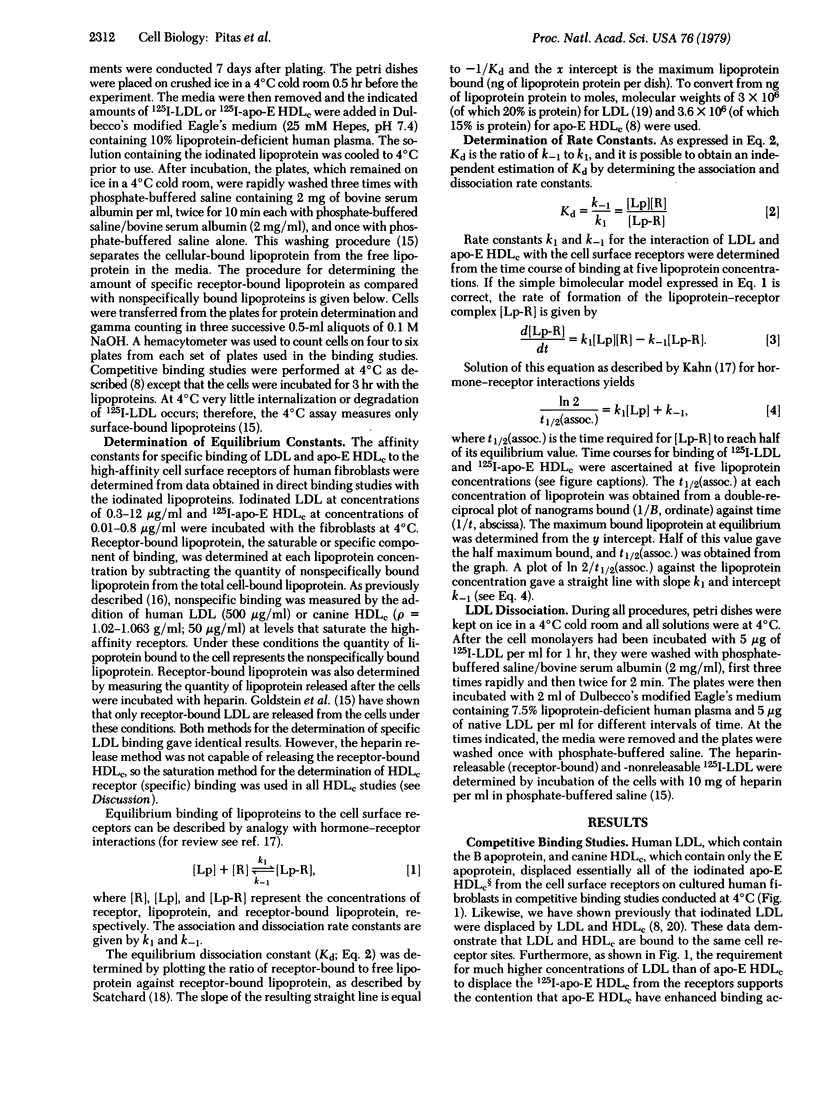Abstract
Competitive binding assays have demonstrated that a cholesterol-induced canine lipoprotein containing only the E apoprotein (apo-E HDLc) binds to the same cell surface receptors of human fibroblasts as human low density lipoproteins (LDL). However, the apo-E HDLc have a much greater binding activity than LDL. Equilibrium and kinetic binding studies were conducted at 4°C to determine the mechanism for this enhanced receptor binding activity. Based on the data, the binding of both LDL and apo-E HDLc appears to be a simple bimolecular receptor interaction, and no heterogeneity of binding sites or cooperative effects among the receptor sites were observed. Equilibrium dissociation constants determined by Scatchard analysis of the equilibrium binding data for apo-E HDLc (Kd = 0.12 × 10-9 M) and LDL (Kd = 2.8 × 10-9 M) revealed a 23-fold greater affinity of HDLc for the receptors. Association and dissociation rate constants for the lipoprotein-receptor complex were determined from the time course of binding at various lipoprotein concentrations. The equilibrium dissociation constants calculated from these kinetic data confirmed that apo-E HDLc had a much higher affinity for the receptor than LDL. Furthermore, the kinetic studies indicated that apo-E HDLc bound more rapidly than LDL with rates of association of 18.0 × 104 and 5.5 × 104 M-1 sec-1, respectively. The rate of dissociation of the apo-E HDLc-receptor complex (1.7 × 10-5 sec-1) was slower than that of the LDL receptor complex (6.3 × 10-5 sec-1). An additional important difference between the binding of apo-E HDLc and LDL was that 4 times (3.6 ± 0.4) as many LDL particles as HDLc particles were required for saturation of the receptors at maximal binding. These data indicate that each HDLc particle binds to multiple cell surface receptors at a ratio of 4:1 for LDL receptor binding.
Keywords: cholesterol metabolism, low density lipoprotein receptors, atherosclerosis
Full text
PDF




Selected References
These references are in PubMed. This may not be the complete list of references from this article.
- Bersot T. P., Mahley R. W., Brown M. S., Goldstein J. L. Interaction of swine lipoproteins with the low density lipoprotein receptor in human fibroblasts. J Biol Chem. 1976 Apr 25;251(8):2395–2398. [PubMed] [Google Scholar]
- Bilheimer D. W., Eisenberg S., Levy R. I. The metabolism of very low density lipoprotein proteins. I. Preliminary in vitro and in vivo observations. Biochim Biophys Acta. 1972 Feb 21;260(2):212–221. doi: 10.1016/0005-2760(72)90034-3. [DOI] [PubMed] [Google Scholar]
- Bolton A. E., Hunter W. M. The labelling of proteins to high specific radioactivities by conjugation to a 125I-containing acylating agent. Biochem J. 1973 Jul;133(3):529–539. doi: 10.1042/bj1330529. [DOI] [PMC free article] [PubMed] [Google Scholar]
- Brown M. S., Goldstein J. L. Analysis of a mutant strain of human fibroblasts with a defect in the internalization of receptor-bound low density lipoprotein. Cell. 1976 Dec;9(4 Pt 2):663–674. doi: 10.1016/0092-8674(76)90130-6. [DOI] [PubMed] [Google Scholar]
- Brown M. S., Goldstein J. L. Familial hypercholesterolemia: defective binding of lipoproteins to cultured fibroblasts associated with impaired regulation of 3-hydroxy-3-methylglutaryl coenzyme A reductase activity. Proc Natl Acad Sci U S A. 1974 Mar;71(3):788–792. doi: 10.1073/pnas.71.3.788. [DOI] [PMC free article] [PubMed] [Google Scholar]
- Fisher W. R., Hammond M. G., Warmke G. L. Measurements of the molecular weight variability of plasma low density lipoproteins among normals and subjects with hyper- -lipoproteinemia. Demonstration of macromolecular heterogeneity. Biochemistry. 1972 Feb 15;11(4):519–525. doi: 10.1021/bi00754a006. [DOI] [PubMed] [Google Scholar]
- Goldstein J. L., Basu S. K., Brunschede G. Y., Brown M. S. Release of low density lipoprotein from its cell surface receptor by sulfated glycosaminoglycans. Cell. 1976 Jan;7(1):85–95. doi: 10.1016/0092-8674(76)90258-0. [DOI] [PubMed] [Google Scholar]
- Goldstein J. L., Brown M. S., Stone N. J. Genetics of the LDL receptor: evidence that the mutations affecting binding and internalization are allelic. Cell. 1977 Nov;12(3):629–641. doi: 10.1016/0092-8674(77)90263-x. [DOI] [PubMed] [Google Scholar]
- Goldstein J. L., Brown M. S. The low-density lipoprotein pathway and its relation to atherosclerosis. Annu Rev Biochem. 1977;46:897–930. doi: 10.1146/annurev.bi.46.070177.004341. [DOI] [PubMed] [Google Scholar]
- Innerarity T. L., Mahley R. W. Enhanced binding by cultured human fibroblasts of apo-E-containing lipoproteins as compared with low density lipoproteins. Biochemistry. 1978 Apr 18;17(8):1440–1447. doi: 10.1021/bi00601a013. [DOI] [PubMed] [Google Scholar]
- Innerarity T. L., Mahley R. W., Weisgraber K. H., Bersot T. P. Apoprotein (E--A-II) complex of human plasma lipoproteins. II. Receptor binding activity of a high density lipoprotein subfraction modulated by the apo(E--A-II) complex. J Biol Chem. 1978 Sep 10;253(17):6289–6295. [PubMed] [Google Scholar]
- Mahley R. W., Innerarity T. L. Interaction of canine and swine lipoproteins with the low density lipoprotein receptor of fibroblasts as correlated with heparin/manganese precipitability. J Biol Chem. 1977 Jun 10;252(11):3980–3986. [PubMed] [Google Scholar]
- Mahley R. W., Innerarity T. L., Pitas R. E., Weisgraber K. H., Brown J. H., Gross E. Inhibition of lipoprotein binding to cell surface receptors of fibroblasts following selective modification of arginyl residues in arginine-rich and B apoproteins. J Biol Chem. 1977 Oct 25;252(20):7279–7287. [PubMed] [Google Scholar]
- Mahley R. W., Innerarity T. L., Weisgraber K. H., Fry D. L. Canine hyperlipoproteinemia and atherosclerosis. Accumulation of lipid by aortic medial cells in vivo and in vitro. Am J Pathol. 1977 Apr;87(1):205–226. [PMC free article] [PubMed] [Google Scholar]
- Mahley R. W., Weisgraber K. H., Innerarity T., Brewer H. B., Jr, Assmann G. Swine lipoproteins and atherosclerosis. Changes in the plasma lipoproteins and apoproteins induced by cholesterol feeding. Biochemistry. 1975 Jul;14(13):2817–2823. doi: 10.1021/bi00684a005. [DOI] [PubMed] [Google Scholar]
- Mahley R. W., Weisgraber K. H., Innerarity T. Canine lipoproteins and atherosclerosis. II. Characterization of the plasma lipoproteins associated with atherogenic and nonatherogenic hyperlipidemia. Circ Res. 1974 Nov;35(5):722–733. doi: 10.1161/01.res.35.5.722. [DOI] [PubMed] [Google Scholar]
- Weisgraber K. H., Innerarity T. L., Mahley R. W. Role of lysine residues of plasma lipoproteins in high affinity binding to cell surface receptors on human fibroblasts. J Biol Chem. 1978 Dec 25;253(24):9053–9062. [PubMed] [Google Scholar]


